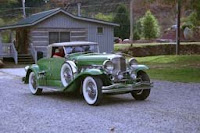The link to Nik Software's Viveza is http://www.niksoftware.com/viveza/usa/entry.php.
You will find good video tutorials if you click on the Lessons link on this site.
Sunday, April 27, 2008
Thursday, April 17, 2008
Adjusting for Improper White Balance
This technique works in both Photoshop and Photoshop Elements.
Open the image that is off color.
If it is not badly off color and there are off color areas which should be white (the highlights) or black (the shadows) use the White Point / Black Point method of color correction. This is:

Open the image that is off color.
If it is not badly off color and there are off color areas which should be white (the highlights) or black (the shadows) use the White Point / Black Point method of color correction. This is:
- Add a Levels Adjustment Layer.
- To find the area that is the lightest in the image which should be white, press the ALT key and press the Highlight slide (the one on the right). The image should go black.
- Drag the slider to the left until a light area appears. This area will be the whites part of the image. Remember where that is.
- Move the slider back to the right and Click the Highlight eyedropper, the right of 3 eyedropers on the right side under Options.
- Click on the area that you found to be the whitest in step 3 and click here with the Highlight eyedropper. You can open the Info palette and you can see the R, G, B valuses as you move the cursor around in the image. When you are at the lightest or brightest part of the image the numbers will be the highest. Clickin in this area will set this area of the image to 255,255,255 or white and neutralize the highlights.
- To neutralize the blacks you follow the same procedure described in steps 2-5 but Alt+drag the black point. The image goes white and the first area to appear is the darkest area of the image. Use the Shadow Eyedropper (the one on the left) and click on the dark area, making this area 0,0,0, neutralizing the shadows.
- With an image that is not far off color, making the highlights and shadows neutral all tones in between should be correct.
- The middle eyedropper is the midtone eyedropper and if there is a neutral gray, 128, 128, 128, you could click this area with the midtone eyedropper and the midtones would be neutralized, removing any color casts.
Most of the time it is difficult to find an area that is a neutral gray, 128, 128, 128 so the following technique works well in these cases.
- With the image open duplicate the background and make the duplicate layer the active layer.
- Go Filter > Blur > Average. This filter averages all the color in the image and changes the image to show this averaged color. This color should be a neutral gray. To make it neutral,
- Add a Levels Adjustment layer.
- Click in the image with the middle eyedropper, the midtone eyedropper.
- This adjusts the tones on this layer to neutral gray. Click OK
- In the Layers palette click the eye next to the background copy layer (now adjusted to be gray) to turn if off or hide it.
- The Levels adjustment layers adjusts all layers under it so the adjustments you set to neutralize the background copy layer will be applied to the background, effectively neutralizing the midtones.
- The image should now look color correct.
- If the highlights or shadows still show a color cast you can apply the white point/black point method described earlier.
- The following images shows the before an after using this technique. Also shown is the Layers palette showing the layers. Layer 1 is the background copy with the Blur > Average filter applied.
 Image Before
Image Before

Monday, April 14, 2008
Simulating Rain
1. Image that you want to add simulated rain
2. Create a New layer name Rain
3. Filter > Noise > Add Noise
a. Amount 95, Mono, Uniform
4. Adjustments > Levels –
a. Move black slider to 71 to increase contrast
5. Blur > Gaussian Blur
a. Radius - .5
6. Blur > Motion Blur
a. Angle 63, 49 amount
7. Filter > Artistic > Plastic Wrap
a. Highlight strength 20,
b. Detail - 14,
c. Smoothness - 3
8. Filter > Other > High Pass
a. Radius = 72
9. Re-apply Motion Blur same settings
10. Blending Mode of Rain Layer set to Hard Light
11. On Background – Adjustments > Levels and move midpoint slider to the to right to darken the image to intensify the rain
12. On Rain Layer – Adjustments > Levels move highlight slider to left to lighten rain
13. Marquee Select bottom of anything like the bottom of a building that would reflect in the foreground
14. Ctrl+J to Copy to new layer
15. Edit > Transform > Flip Vertical
16. Move down and so it sits on pavement
17. Change blending mode to Soft Light
18. Erase reflection from any table tops
2. Create a New layer name Rain
3. Filter > Noise > Add Noise
a. Amount 95, Mono, Uniform
4. Adjustments > Levels –
a. Move black slider to 71 to increase contrast
5. Blur > Gaussian Blur
a. Radius - .5
6. Blur > Motion Blur
a. Angle 63, 49 amount
7. Filter > Artistic > Plastic Wrap
a. Highlight strength 20,
b. Detail - 14,
c. Smoothness - 3
8. Filter > Other > High Pass
a. Radius = 72
9. Re-apply Motion Blur same settings
10. Blending Mode of Rain Layer set to Hard Light
11. On Background – Adjustments > Levels and move midpoint slider to the to right to darken the image to intensify the rain
12. On Rain Layer – Adjustments > Levels move highlight slider to left to lighten rain
13. Marquee Select bottom of anything like the bottom of a building that would reflect in the foreground
14. Ctrl+J to Copy to new layer
15. Edit > Transform > Flip Vertical
16. Move down and so it sits on pavement
17. Change blending mode to Soft Light
18. Erase reflection from any table tops
Simulated Lighting
1. Open scene where you want to add simulated lightning
a. Set foreground color to
i. H - 215
ii. S – 36
iii. B – 33
2. Add New Layer –
3. Choose the Gradient Tool > Linear Foreground to Transparent
a. Drag from the top to the bottom
4. Blend Mode of this layer to Multiply
a. Reduce Opacity to 80%
5. Add New Layer named Lighting
6. Default colors
7. Gradient Tool > Foreground to Background
a. Drag across small distance on a slight angle
8. Filter > Render > Difference Clouds
9. Levels – move Midtone slider to ~ 3.66
10. Invert, Ctrl+I
11. Levels – Mid-tone slider to the right to make black
12. Change to Screen Mode
13. Hue/Sat – check Colorize
14. Move slider to the right
15. For a lighting branch select a Marquee and select lower part of the lighting
16. Crtrl+Shift+J to cut selection to a layer etc.
17. Use Ctrl + T, Free Transform to change size and move into a position to attach it to the main strike.
a. Set foreground color to
i. H - 215
ii. S – 36
iii. B – 33
2. Add New Layer –
3. Choose the Gradient Tool > Linear Foreground to Transparent
a. Drag from the top to the bottom
4. Blend Mode of this layer to Multiply
a. Reduce Opacity to 80%
5. Add New Layer named Lighting
6. Default colors
7. Gradient Tool > Foreground to Background
a. Drag across small distance on a slight angle
8. Filter > Render > Difference Clouds
9. Levels – move Midtone slider to ~ 3.66
10. Invert, Ctrl+I
11. Levels – Mid-tone slider to the right to make black
12. Change to Screen Mode
13. Hue/Sat – check Colorize
14. Move slider to the right
15. For a lighting branch select a Marquee and select lower part of the lighting
16. Crtrl+Shift+J to cut selection to a layer etc.
17. Use Ctrl + T, Free Transform to change size and move into a position to attach it to the main strike.
Liquid Resize Resizing Filter
the Liguid Resize resizing filter is available as a free preview from onOne software, http://www.ononesoftware.com/
Photoshop Express
You can try or sign on for Adobe Photoshop Express Beta
at https://www.photoshop.com/express/landing.html.
Instructions for using Photoshop Express can be found at
http://www.photoshopexpresstechniques.com/
at https://www.photoshop.com/express/landing.html.
Instructions for using Photoshop Express can be found at
http://www.photoshopexpresstechniques.com/
Lightroom 2 Beta
Instructional videos on Lightroom 2 Beta by Julieanne Kost of Adobe are abvailable from http://www.workshopsondemand.com/ps_lightroom/lrb2_p01/
The videos are three parts. Change p01 to p02 and p03 for the 2nd and 3rd parts.
The public Beta of the free Lightroom 2 is available from Adobe Labs at http://labs.adobe.com/technologies/lightroom/
The videos are three parts. Change p01 to p02 and p03 for the 2nd and 3rd parts.
The public Beta of the free Lightroom 2 is available from Adobe Labs at http://labs.adobe.com/technologies/lightroom/
Subscribe to:
Posts (Atom)
